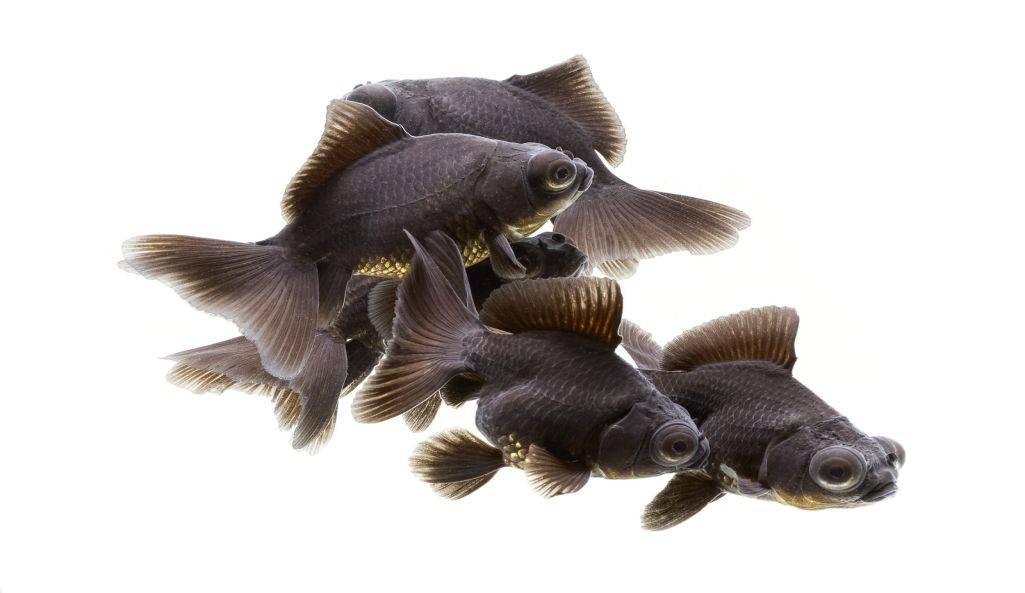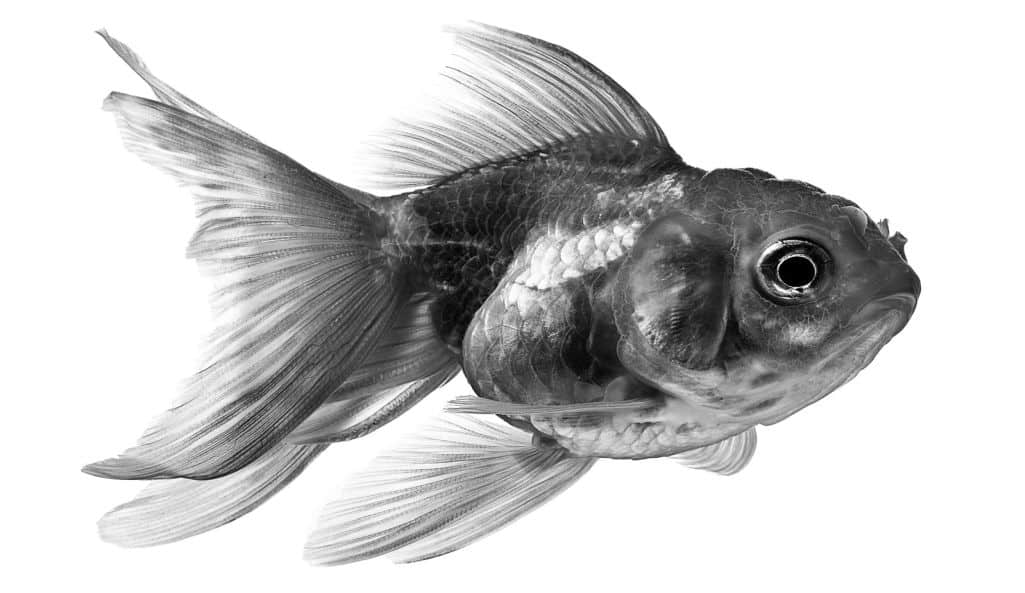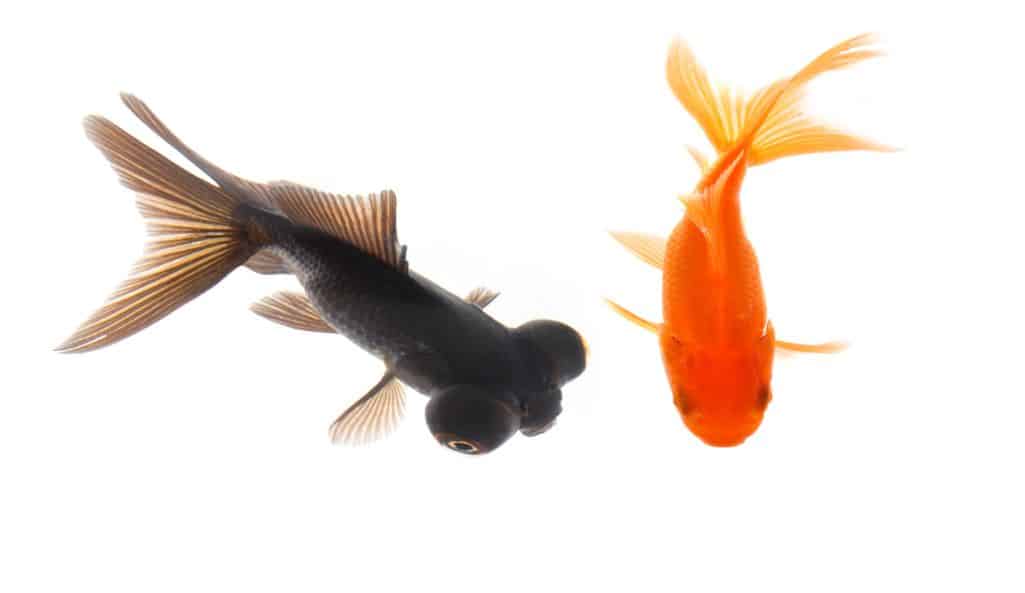Black Moor Goldfish Care (Black Telescope)
The Black Moor Goldfish ( Black Telescope ) are popular aquarium fish and their owners are often smitten by the Moors’ grace and unique appearance.
Both male and female varieties look pretty, with only a few differences in their fin shapes and textures. This is a rare quality among fish, where gender differences are often evident.
The fine quality varieties of these special Telescope Fancy Goldfish aren’t easy to find, so when you find some, try to do your best to keep them well and happy.
These little folks are easy going and quite interactive. They just need a little more care and attention, but we can help. Here’s everything you need to know about Black Moor Goldfish. We’ll take a closer look at their behavior, weaknesses, and the best ways to help them thrive.
Table of Contents
Introduction
Black Moor Goldfish has an Asian origin like many other beautiful aquarium fish such as the Siamese fighting fish, Asian Arowana, and Asian Glass Catfish.
The Moors are pretty ancient decorative fish. Serious breeding of the Blackmoors started in China around the 1700s. They were called ‘Dragon Eyes’ at that time, which goes with the dominant culture back then.
In Japan, these fish are referred to as ‘Black Demekin’ which is a name you’d still here among many breeders. It does fit the Moors nicely, right?
Summary
Class: Actinopterygii
Order: Cypriniformes
Family: Cyprinidae
Genus: Carassius
Species: Auratus
Size: 6-8 inches
Tank size: 10 Gallons min.
Hardiness: Aquarium hardy fish
Optimal temperature: 65-72 degrees F.
Diet: Omnivorous
Lifespan: 5-10 years
Temperament: Docile
Are Black Moors Suitable for Beginners?
Black Moors are generally easy to take care of, but they have a few quirks that need an extra bit of expertise for proper handling.
Their poor eyesight and sensitive bulging eyes are of course the first thing that needs caution. The tank size and decoration have to be suitable for this impairment. The other inhabitants should also be picked carefully to avoid overcrowding or competitive feeding.
Feeding Black Moor Goldfish isn’t complicated, and their menu is quite flexible. Their poor sight intervenes here too, and the aquarium keeper should make sure that they did actually find the food and managed to eat it.
Moors also have a higher than usual requirement for tank maintenance. Anything less than focused care will generally end up with contaminated water and sick fish. Installing filters helps a little with that, but still, this could be an extra load for a beginner.
All in all, Black Moors are lovely and docile. They just need a knowledgeable and skilled human friend to thrive and flaunt their uniqueness.
How to Take Care of Your Black Moor Fish
If you want to keep your Black Moors happy, make sure that you provide them with these three things: good food, clean water, and a big tank.
Good food means that they’ll grow to their full size and stay fit. You also need to give them a varied menu with treats like Blood worms from time to time. A regular feeding schedule goes a long way in maintaining their well being and docile temperament.
Make sure that you don’t offer them too much food per meal. This will end up rotting in the tank and spoiling the water, which takes us to the next point: clean water.
Black Moors are generally sloppy, and this occasionally affects their health. Several parasites target Moors and attach themselves to the fish’s scales. Prevention is the best cure, so start with adjusting meal sizes. Minimizing waste is a good first step to maintaining the tank’s hygiene.
Change the tank water every two weeks or so. You don’t have to remove all the water, just one-third of the tank water is sufficient. Black Moors adjust to the parameters of their aquarium, and drastic changes give them a bit of a shock.
You can also add a water filtration system to eliminate algae and other contaminants from the aquarium. Make sure that it doesn’t cause much commotion around the tank or excessive water currents. Moors aren’t great swimmers, and the turbulent waters could exhaust them.
What’s the Best Tank Size for a Black Moor?

Black Moors aren’t skillful in navigating tanks and avoiding obstacles. That’s why they need plenty of open space. It’s recommended to give each Moor fish about ten gallons of clear tank water.
This might sound like too much square footage for a single fish, but you have to see how they can injure their eyes or damage their tail fins to appreciate their need for space. Crowded enclosures aren’t suitable for these lovely sensitive fish.
Some fish breeders use other types of tanks with plastic padding. These arrangements offer larger capacities and softer borders. Both aspects are good for Black Moors. There’s a caveat though, the sides of the tank aren’t transparent, so you can only monitor the fish from the top.
Cleaning the Tank
Moor fish can live for up to 10 years. Their longevity depends largely on the aquarium water quality, as cleanliness decreases the possibility of the fish getting sick. Do your best to keep the fish in a healthy biome.
Changing the aquarium water every other week is optimal. Fish aren’t very fond of drastic changes in their environment, so we try to balance their need for stability with the importance of keeping the tank water pathogen-free.
When you renew the tank water, aim at changing about one-third of the quantity. If you change more than that your fish could feel alienated and become distressed. Their home would feel too different and they appreciate familiarity.
Chlorinated tap water isn’t suitable for almost all aquarium fish and moor fish is no different. Let the tap water sit overnight to make sure most of the chlorine evaporates. You could speed up this waiting period by using a tap water conditioner to neutralize the chlorine.
If you decide to use aquarium water filters, you wouldn’t have to renew the tank water that frequently.
Using Filters
Moor fish aren’t the neatest aquarium fish you’d come across. They’re messy eaters and they produce significant amounts of waste.
The aquarium water can quickly become contaminated, which is unhealthy for the fish. Prevention is the best approach and using a filter effectively limits the growth of fungi or bacteria.
You could use a mechanical or an ultraviolet filter to clear the tank water. There are also chemical and biological alternatives that you might want to consider, but filters are a good choice in most cases.
Make sure that the filter doesn’t have sharp edges and place it away from the usual path of your Moor fish. They can’t tell if there’s an object in front of them and will easily crash into it head-on.
Tank Decorations
Black moors are like bats but without the ultrasound echo guidance. They have limited eyesight, which affects their ability to understand their surroundings.
These unsuspecting fish could easily bump into tank decorations or gravel. That’s why it’s best to keep these objects to an absolute minimum. Sharp-edged items could pose an extra risk as the fish could swim into them and hurt their eyes or fins.
The aquarium should also be wide enough for the fish to swim without running into walls. Rectangular tanks are often recommended over the spherical bowl-shaped tanks.
Other aquarium owners propose the idea that circular walls are less likely to cause issues with the fish than sharp corners.
In all cases, choose a wide enough tank to make sure the moor fish has enough space to swim safely. Try not to splurge on the aquarium themes and props, as this specific type of fish wouldn’t be able to appreciate the view.
Aquarium Temperature
Many aquarium owners let their fish enjoy the ambient temperature, especially in the spring or fall when the temperatures are mild. This should be okay, and Black Moor Goldfish can take it nicely.
Abrupt changes in temperature or extreme gradation aren’t quite as easy on the fish. If the aquarium is placed near a window, it’ll warm up during the day, then cool off in the afternoon. This wide range of variation is hard on any fish, and it’s especially severe on the Moors.
Placing the tank near a radiator, fireplace, or air condition has the same effect. Even an open door, where a draft is likely to enter the room can be harmful to the fish.
You can maintain the consistency of the tank environment by installing a water heater. Adjust the temperature between 65 and 72 degrees. As we mentioned, Black Moors are quite tolerant and they can survive in a wider range of temperatures, but this is their optimal biome.
Transportation

The telescopic bulging eyes of the Moors are their most prominent feature. They’re also their Achilles heel.
The Black Moors are quite vulnerable around their eyes. Injuries don’t just happen when they bump into objects. They could also be scratched while netted for transportation from one tank to another.
It’s best not to use a net at all. Don’t be tempted to catch them with your hands either. They’re slow swimmers and you can easily catch them, but this could damage their eyes and fins.
Get a small plastic bucket with a smooth interior and use it to move your fish. Let them in softly by the sheer movement of the bucket underneath them. Let them out in a similar fashion. Immerse the plastic bucket and they’ll swim out into the new tank.
Feeding Your Black Moors
Food is an essential part of any living creature’s day. It’s a primary cause for health and happiness, so we’ll talk a bit about the optimal feeding of your Black Moors
What Do They Eat?
Moor fish are omnivorous, which means they can eat anything meat or plant. Live prey is also good, and they’ll get excited if you offer it. They fancy a fresh meal of bloodworms from time to time, so try to include it in their feeding schedule.
They also like fish flakes and pellets. There’s an extra good side to pellets, which is adjusting the meal size to fit the fish’s appetite. Counting how many pellets is easier than eyeballing how much flake or powder fish food.
How Much?
The fish food packages often recommend meal sizes and feeding frequencies more than the optimal for average fish. Read the labels and take their recommendations into consideration, but observe how your fish respond to food.
You don’t want the fish to leave plenty of uneaten food lying about in the tank. Once it reaches the bottom, most fish wouldn’t be able to snack on it later. It’ll just decay and spoil the tank water.
Overeating is also a possibility for some fish and it often makes them sluggish and cranky. In some cases, constant overeating could affect the fish’s swim bladder. It’s better to err on the side of light feeding both in terms of quantity and meal times.
How Often?
Feeding your moors twice a day is more than sufficient. They can also take a day off feeding to rest their digestive system. Regular mealtimes are always healthier than random feedings.
The fish’s age should also be considered in planning the Moor’s feeding schedule. Growing fish need more food than adults. The type of food you offer might also be a bit different. Smaller softer varieties are best.
Seasonal Changes
Seasonal changes affect wild fish much more than they do aquarium fish. Fish normally have hibernation cycles where they eat minimal amounts of food, and high energy cycles when they can’t stop gobbling up whatever comes their way.
You’ll probably adjust the water temperature with a heater, so it’ll be constant all year round. This means that you wouldn’t notice huge variations in the Moor’s appetite associated with the weather outside.
How Long Do Black Moor Goldfish Live?
Black Moors are descendants of Carp fish, which is a species known for its longevity. Moores can live up to ten years, but they usually lead happy aquarium lives for about five years.
Occasionally, we see Black Moors living in aquariums for a year or less. This is mostly because of limited tank capacity or poor hygiene. As we mentioned earlier, Moors aren’t sleek fish. Their tank water needs to be well maintained to keep them in good health.
Water temperature, oxygen saturation, and excessive chlorination could also affect their longevity. Monitoring tank parameters is a crucial activity when you’re growing fish. Luckily, these conditions are all easily automated. Just install the proper devices.
Last but not least, Black Moor Goldfish are pretty sociable. Include a few of their own in the aquarium. A bustling social life should help them to stay happy and thrive. Human friends aren’t any less important. Fish interact with their humans and build trust with every passing day.
Longevity is highly dependent on general wellbeing in any species. Following these steps should keep the Black Moors thriving for quite a while.
Can Black Moors Live with Other Goldfish?

Black moors are sweet, docile, and quite sociable to other fish. Putting the Moors with other Goldfish is theoretically okay, especially since they share the same general water temperature and feeding routines, but there’s a catch.
Moors are also slow, clumsy, and a little messy. They generate considerable waste in the tank, and their personal hygiene isn’t exemplary. They also need a lot of free clear space around the pool to stay out of harm’s way.
This isn’t a typical environment for the quicker and neater Goldfish. It’s a bit risky as well for the demure Black moors, as they’d have a hard time competing for food. It might be hard to avoid the occasional bumping with the fast swimming Goldfish.
Goldfish look best around elaborate tank decorations, and these items aren’t suitable around Black Moors, so that’s another roadblock that stands in the way of their cohabitation.
Temporary arrangements can be fine though. Both the Goldfish and the Black Moors aren’t likely to start any fights, and they can totally play nice.
Black Moors have a lot in common with Telescope Goldfish which is the reason they often also referred to as Black Telescope. They have the same impaired vision and slow movement, so they can fit well in the same tank, as long as the overall capacity sustains all of them.
Do Black Moors (Black Telescope) Change Color?
It comes as a huge surprise to many pet owners that their lovely velvet blackfish is no longer black.
Moors sometimes experience a process called de-melanization, which transforms their dark scale color to bright orange. This could happen naturally as they age, or there could be other reasons related to their environment like water temperature and acidity.
Some diseases also cause the Moors to lose their dark shades. The velvet disease is caused by a parasite and it affects the scales first, then the rest of the fish’s organs. This is luckily an infrequent incident.
Conclusion
Taking care of Black Moor Goldfish is an overwhelming task for many breeders, but not to you! These lovely fish just need you to get to know them a bit more. They’re not needy or overly sensitive, just a bit more vulnerable.
Their beautiful appearance makes them a sight to look at all day. It’s also the reason why they’re not adept swimmers, and a little skittish around hard objects.
Here’s a nice parting thought: Black Moors spawn around spring, and you can mimic that in the aquarium by gradually raising the temperature of the water. Remove the mom and dad fish when they lay their eggs, and 8 weeks later, you’ll have a large litter of baby Moors to play with!
11 Best Black Moor Goldfish Tank Mates (With Pictures)




